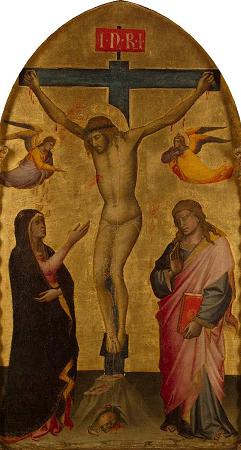Saint John Evangelist. John the Evangelist is the name traditionally given to the author of the Gospel of John. Christians have traditionally identified him with John the Apostle, John of Patmos, or John the Presbyter, although this has been disputed by modern scholars. The Gospel of John refers to an otherwise unnamed disciple whom Jesus loved, who bore witness to and wrote the Gospel's message. The author of the Gospel of John seemed interested in maintaining the internal anonymity of the author's identity, although interpreting the Gospel in the light of the Synoptic Gospels and considering that the author names Peter, and that James was martyred as early as 44 AD it has been widely believed that the author was the Apostle John. Christian tradition says that John the Evangelist was John the Apostle. The Apostle John was one of the pillars of the Jerusalem church after Jesus' death. He was one of the original twelve apostles and is thought to be the only one to have lived into old age and not be killed for his faith. It had been believed that he was exiled to the Aegean island of Patmos, where he wrote the Book of Revelation. However, some attribute the authorship of Revelation to another man, called John the Presbyter, or to other writers of the late first century AD. Orthodox Roman Catholic scholarship, most Protestant churches, and the entire Eastern Orthodox Church attribute all of the Johannine literature to the same individual, the Holy Apostle and Evangelist, John the Theologian, whom it identifies with the Beloved Disciple in the Gospel of John. Main articles: Authorship of the Johannine works and Johannine epistles The authorship of the Johannine works has been debated by scholars since at least the 2nd century AD. The main debate centers on who authored the writings, and which of the writings, if any, can be ascribed to a common author. Orthodox tradition attributes all of the Johannine books to John the Apostle. In the 6th century, the Decretum Gelasianum argued that Second and Third John have a separate author known as John, a priest. Historical critics sometimes reject the view that John the Apostle authored any of these works. Most modern scholars believe that the apostle John wrote none of these works, although some, such as J.A.T. Robinson, F. F. Bruce, Leon Morris, and Martin Hengel, hold the apostle to be behind at least some, in particular the gospel. There may have been a single author for the gospel and the three epistles. Some scholars conclude the author of the epistles was different from that of the gospel, although all four works originated from the same community. The gospel and epistles traditionally and plausibly came from Ephesus, c. 90-110, although some scholars argue for an origin in Syria. In the case of Revelation, most modern scholars agree that it was written by a separate author, John of Patmos, c. 95 with some parts possibly dating to Nero's reign in the early 60s. The feast day of Saint John in the Catholic Church, which calls him Saint John, Apostle and Evangelist, and in the Anglican Communion and Lutheran Calendars, which call him John, Apostle and Evangelist, is on 27 December, the third day of Christmastide. In the Tridentine Calendar he was commemorated also on each of the following days up to and including 3 January, the Octave of the 27 December feast. This Octave was abolished by Pope Pius XII in 1955. The traditional liturgical color is white. John is traditionally depicted in one of two distinct ways: either as an aged man with a white or gray beard, or alternatively as a beardless youth. The first way of depicting him was more common in Byzantine art, where it was possibly influenced by antique depictions of Socrates; the second was more common in the art of Medieval Western Europe and can be dated back as far as 4th century Rome. In medieval works of painting, sculpture and literature, Saint John is often presented in an androgynous or feminized manner. Historians have related such portrayals to the circumstances of the believers for whom they were intended. For instance, John's feminine features are argued to have helped to make him more relatable to women. Likewise, Sarah McNamer argues that because of John's androgynous status, he could function as an image of a third or mixed gender and a crucial figure with whom to identify for male believers who sought to cultivate an attitude of affective piety, a highly emotional style of devotion that, in late-medieval culture, was thought to be poorly compatible with masculinity. Legends from the Acts of John contributed much to medieval iconography; it is the source of the idea that John became an apostle at a young age.
more...














